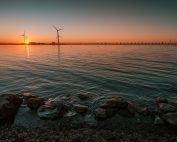MEPs will adopt an opinion on offshore strategy at the ITRE Committee meeting on Thursday. The author is Morten Petersen, Member of the European Parliament and Vice-Chairman of the Committee on Industry, Research and Energy (ITRE).
In a recent special interview with BalticWind.EU, the Danish politician argued that the European strategy for renewable energy at sea is a key element in achieving the EU’s 2030 renewable energy targets.
„I cannot see a way for us to get to where we want to get, without tapping into the huge potential of offshore renewable energy. It is of course a given that the strategy is just the starting point. Once we make sure that the strategy aligns with our level of ambition for 2030, we need to follow up on our promises and continue pushing forward. Achieving the targets requires a constant battle to strengthen the right decisions and correct the course when needed.” – stressed Morten Petersen.
On November 19, 2020, the European Commission published the EU strategy to harness the potential of offshore renewable energy for a climate-neutral future. This Strategy on Offshore Renewable Energy was widely anticipated as part of the European Green Deal and envisaged in the Commission’s 2020 Work Program. Stakeholder consultations took place during 2020, including an online public consultation that ended on 24 September 2020.
The Strategy on Offshore Renewable Energy aims to drastically increase the EU’s offshore renewable electricity production from 12 gigawatts now to over 60 GW until 2030 and 300 GW until 2050.
In addition, Member of European Parliament, Jerzy Buzek, former chairman of the ITRE committee, indicated in a recent interview with BalticWind.EU that the Baltic Sea will play a significant role in the transformation of the EU.
”With the massive shift towards electrification of our energy systems based in large on renewable energy generation, the Baltic Sea represents a truly unique potential for the countries of this region to transform their energy systems in line with the European Green Deal objectives. This is about offshore wind projects as mass scale renewable energy generation source; scaling up renewable hydrogen production as clean fuel of the future; advancing EU’s energy system integration in an unprecedented and innovative way through hybrid projects and integrated grid; putting in place new tools and mechanisms for joint investments in offshore projects and energy trade; developing a new approach to energy security, balancing and flexibility of our energy systems. If we succeed in all of this, Baltic Sea will greatly contribute to so much needed energy “wind of change” in the whole EU!” – said Jerzy Buzek.
The strategy aims to facilitate the nearly EUR 800 billion essential investment in offshore renewable energy until 2050 by increasing investor confidence and smoothing the path of investment, easing bottlenecks, and finding the best combination of public and private funding. Regional cooperation is essential to achieving this goal and ensuring that renewable technologies are developed not only in the North Sea (where most offshore wind projects are currently located), but also in the Baltic Sea, Mediterranean Sea, Black Sea, Atlantic Ocean, Outermost Regions and Overseas Territories.














